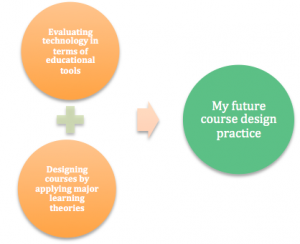Précis of my flight path
The three most important goals that I wanted to achieve through ETEC 565A were learning effective ways to incorporate social media into online class activities so that teachers and learners can achieve more vibrant and quality communication, designing effective course content using learning management systems (LMS) or other web-based applications, and lastly, designing and implementing assessment tools for effective evaluation in online classes.
My eLearning toolkit experiences
I focused on learning three e-learning toolkits throughout the course following my flight path- utilizing LMS, Social Media and Discussion Board.
![]() The first toolkit was LMS (Learning Management System). This was the first time I designed course modules in LMS. I had prior knowledge about installing and configuring Moodle as an administrator but designing a course in Moodle was an absolutely enlightening experience. I designed the course to focus on Anderson’s (2008) three forms of interaction: student-teacher, student-student and student-content. Anderson states that deep and meaningful learning can be developed when one of the three forms of interaction is at an enriched level. (Anderson, p 67) During the course designing process, I realized that meaningful interaction depends on how teachers and course designers design activities to encourage students’ active participation. Another meaningful experience in the Moodle course design was using Moodle quiz tools and the workshop feature to design assessments as part of extended learning. The exam and workshop provided students with constructive learning opportunities – further reading suggestions, course content URLs associated with the questions, and peer and self-assessment – to foster the assessments to be an extent of learning (Gibbs & Simpson, p. 17).
The first toolkit was LMS (Learning Management System). This was the first time I designed course modules in LMS. I had prior knowledge about installing and configuring Moodle as an administrator but designing a course in Moodle was an absolutely enlightening experience. I designed the course to focus on Anderson’s (2008) three forms of interaction: student-teacher, student-student and student-content. Anderson states that deep and meaningful learning can be developed when one of the three forms of interaction is at an enriched level. (Anderson, p 67) During the course designing process, I realized that meaningful interaction depends on how teachers and course designers design activities to encourage students’ active participation. Another meaningful experience in the Moodle course design was using Moodle quiz tools and the workshop feature to design assessments as part of extended learning. The exam and workshop provided students with constructive learning opportunities – further reading suggestions, course content URLs associated with the questions, and peer and self-assessment – to foster the assessments to be an extent of learning (Gibbs & Simpson, p. 17).
 The second toolkit was Social Media Software. I utilized Social Media for the digital story telling activity and for a part of discussion activity in the Moodle course. There have been lots of social media websites and cloud based web services companies since web 2.0 technologies came into the main stream on Internet. It is inevitable that 21st century learners must acquire multiliteracies – digital literacy, information literacy, visual literacy, and multimedia literacy – to achieve successful learning in a technology oriented environment. Incorporating these social media tools into a course promotes meaningful student interactions and also foster collective knowledge building. Social media services like Pintrest, Twitter and Facebook definitely have high potential to provide students and a teachers with the opportunity to construct knowledge collaboratively as a learning community (Scardamalia & Bereiter, p. 272).
The second toolkit was Social Media Software. I utilized Social Media for the digital story telling activity and for a part of discussion activity in the Moodle course. There have been lots of social media websites and cloud based web services companies since web 2.0 technologies came into the main stream on Internet. It is inevitable that 21st century learners must acquire multiliteracies – digital literacy, information literacy, visual literacy, and multimedia literacy – to achieve successful learning in a technology oriented environment. Incorporating these social media tools into a course promotes meaningful student interactions and also foster collective knowledge building. Social media services like Pintrest, Twitter and Facebook definitely have high potential to provide students and a teachers with the opportunity to construct knowledge collaboratively as a learning community (Scardamalia & Bereiter, p. 272).
![]() The third toolkit was a discussion forum that was leveraged as an asynchronous communication tool. I chose to create an Interactive writing activity using an “Asynchronous Communication” tool to amplify meaningful and deep interactions within learning communities. A discussion forum is the right communication tool to promote a community of inquiry model (Anderson, 2008). The model postulates that sufficient levels of three types of component presence – cognitive presence, teacher presence and social presence – foster deep and meaningful learning results (Anderson, p. 344).
The third toolkit was a discussion forum that was leveraged as an asynchronous communication tool. I chose to create an Interactive writing activity using an “Asynchronous Communication” tool to amplify meaningful and deep interactions within learning communities. A discussion forum is the right communication tool to promote a community of inquiry model (Anderson, 2008). The model postulates that sufficient levels of three types of component presence – cognitive presence, teacher presence and social presence – foster deep and meaningful learning results (Anderson, p. 344).
Reflection about overall ETEC565A experience
 I acquired two vital skills: evaluating technology in terms of educational tools, and designing courses by applying major learning theories: social constructivism, situated learning and communities of practice.
I acquired two vital skills: evaluating technology in terms of educational tools, and designing courses by applying major learning theories: social constructivism, situated learning and communities of practice.
First, using Bates & Poole ‘s framework (Bates and Poole, 2003) helped me choose the right tools to deliver learning content throughout the course assignments. It is useful to have such a framework to evaluate educational technology. Moving forward, I will definitely use the framework to design meaningful learning experiences for a number of courses.
Second, ETEC565A provided me with skills and insights to design courses employing social constructivism, situated learning and communities of practice. According to social constructivism, learning “requires exchanging, sharing, and negotiation, as well as occasionally drawing on the expertise of more knowledgeable individuals.” and it “involves both personal inner process and social aspect” (Liu, Lin, Chiu, & Yuan, 2001, p. 247). The discussion forums in ETEC 565A definitely provided us with social learning opportunities through knowledge sharing and negotiation. I believe that some learners made significant efforts to share their knowledge within the learning community. It was a great community to be in.
Lastly, according to situated learning, meaningful learning will only occur if it is embedded in the social and physical context within which it will be used (Brown et al 1989). Developing an evaluation rubric in a group and designing course modules in Moodle are authentic activities that take place in real-world context and are meaningful to us in terms of needs and interests. I believe that carefully selected tasks or activities in ETEC 565A, e.g. creating our own course modules, designing assessment tools, analyzing real-world course design practices, and evaluating educational tools, enhanced ETEC 565A students’ understanding of the real world experience of a course designer. Moreover, creating the evaluation rubric in a team affords social and intellectual interactions that support shared learning goals.
Moving Forward
Overall, I achieved most of my learning goals in ETEC 565A because I set my flight path to be very specific. I was able to apply the knowledge gained through ETEC 565A readings and the additional reading list I planned to employ. However, a couple of areas that I have not utilized in the course modules are designing and creating my own video learning materials using Mac iMovie or any movie maker tools, and designing and creating e-learning content using e-learning design tools such as Camtasia and Captivate. I wish that I had time to practice with these tools. I am planning to explore these tools before the next semester starts and hopefully, produce sample content and add it to my e-portfolio.
It appears that taking other online courses at Coursera and Udacity would help me stay engaged as a lifelong learner in terms of educational technology. Participating in other online courses will help me comprehend the learning environment from a learner’s perspective – a standpoint that instructional designers often overlook during the process of designing online courses.
References:
Anderson, T. (2008). Towards a Theory of Online Learning. In: Anderson, T. & Elloumi, F. Theory and Practice of Online Learning. Athabasca University. Accessed online 3 March 2009.
http://www.aupress.ca/books/120146/ebook/02_Anderson_2008-Theory_and_Practice_of_Online_Learning.pdf
Bates and Poole. (2003) “A Framework for Selecting and Using Technology.” In Effective Teaching with Technology. San Francisco: Jossey-Bass. Pages 75-105
Brown, J. S., Collins, A. & Duguid, S. (1989). Situated cognition and the culture of learning. Educational Researcher, 18, 32-42.
Liu, E. Z., Lin, S. S., Chiu, C. H., & Yuan, S. M. (2001). Web-based peer review: The learner as both adapter and reviewer. IEEE Transactions on Education, 44(3), 246-251.
Scardamalia, M. and Bereiter, C. (1993). Support for knowledge-building communities. The Journal of Learning Sciences 3(3), 265-283.
